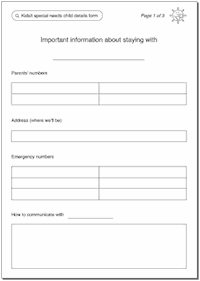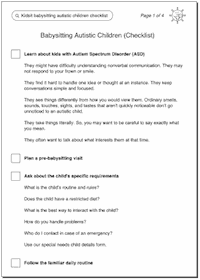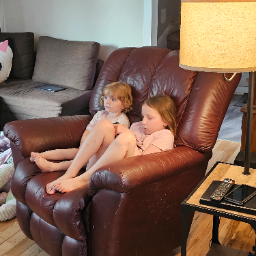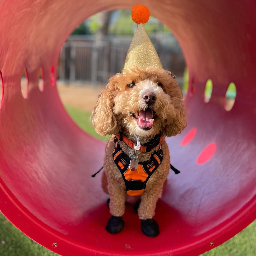How to Babysit Autistic Children (13 Tips, Appropriate Activities + Checklist)


Written by
Annabelle Carter Short
Autism Awareness Advocate

Babysitting Video by
Lydia Kutz
Babysitter, Infant Swimming Resources Instructor

Medically Reviewed by
Gina Maria Jansheski, MD, FAAP
Board-Certified Pediatrician, Medical Reviewer

Illustrated by
Matthew James Taylor
Kidsit Founder, General Manager
Key Takeaways
- Understand Autism Spectrum Disorder (ASD): Autistic children may have difficulty understanding nonverbal communication, process information differently, and be sensitive to sensory stimuli.
- Prepare in Advance: Learn about the child's specific needs, routines, and preferences before babysitting. A pre-visit can help establish rapport and reduce anxiety.
- Maintain Consistent Routines: Following familiar daily routines can provide a sense of security and predictability for the child.
- Use Clear and Simple Communication: Avoid figurative language and be direct. Visual aids, like schedules or social stories, can enhance understanding.
- Respect Sensory Sensitivities: Be mindful of the child's sensory preferences and avoid overwhelming them with loud noises, bright lights, or strong smells.
- Engage in Appropriate Activities: Activities like crafts, puzzles, or video games can be enjoyable and calming. Tailor activities to the child's interests and abilities.
- Be Patient and Flexible: Autistic children may have unique responses to situations. Patience and flexibility are key in providing effective care.
- Ensure Safety: Create a safe environment by securing potentially harmful items and being vigilant about the child's whereabouts and activities.
- Build Trust with Parents: Maintain open communication with the child's parents to ensure continuity of care and address any concerns or updates.
Babysitting is not easy, whether or not you are looking after a child with autism. With the advancement of digital media, it’s challenging to maintain kids’ attention. However, that is one of the reasons you like this exciting job, right?
Autistic children think and process information differently than typical kids. They can be charming and exceptional, which makes it interesting to spend time with them. Depending on where the child falls on the autism spectrum, they will have varying abilities and communication levels. Therefore, you should be aware of their needs and take the time to prepare.
How to babysit a child who has autism:
- Take some time to learn about autism
- Plan a pre-babysitting visit
- Learn the child’s specific requirements
- Follow the familiar daily routine
- Try crafts, video gaming, and solving puzzles
- Less communication means more connection
- Avoid bodily contact and respect personal space
- Go slow on power struggles
- Make the unknown familiar
This article covers the various aspects of babysitting kids with autism, including how to prepare, effective care strategies, safety, and fun activities to enjoy together. Although babysitting an autistic child can be challenging at first, knowing what to do will make the interaction a rewarding one.
Lydia has been working in the childcare industry for 15 years, and owned a childcare agency in Florida, USA for 7 years. In this video she interviews Kristina Madden from Madden Therapy Solutions. Kristina is a pediatric speech pathologist and has been working with children for over 16 years with a variety of diagnosies from birth to adulthood. Lydia and Kristina provide insight on how to work with children while babysitting who may be on the autism spectrum.
1. Take Some Time to Learn About Autism
The more you understand the condition, the easier it will be for you, and the more comfortable you will be when caring for the child. Autism Spectrum Disorder (ASD) has the potential to greatly impact a child’s development. It is known as a spectrum disorder because kids can be anywhere on the autism spectrum, meaning some are more affected and have more of the characteristic behavior patterns than others.
Kids with the disorder start showing symptoms from an early age. They may not be recognized, however, until toddlerhood. The symptoms usually will, to some extent, continue into the adult years.
Children with ASD have difficulty relating to other people. Some are not comfortable making eye contact. Many have not developed ordinary language, but those who do talk are usually fixated on a topic they are passionate about. The setback is that they might talk about it for a prolonged period and have quite limited interaction with the person they are talking to.
Although ASD doesn’t have a cure yet, there is hope for improved functioning in all areas through treatment and early intervention. The aim is to help children to interact and communicate with others.
What should you know about autism when babysitting?
Quick Facts About Kids with ASD
- They might have difficulty comprehending nonverbal communication. They may not be able to read, understand, or respond to your frown or smile.
- They find it hard to handle more than one idea or thought at a time. They are better when you keep conversations simple and focused.
- They see things differently from how you would view them. Ordinary smells, sounds, touches, sights, and tastes that aren’t quickly noticeable don’t go unnoticed to an autistic child. Some perfectly normal routine sounds can be unbearably loud to them, and send them into a fearful episode or tantrum.
- They don’t understand the nuances of language and take things literally. They may not get what you mean by a figure of speech. So, you’ll want to be careful to say exactly what you mean.
- Many have not developed typical speech, and may just make sounds or signs, speak in a made-up language, or simply echo what you are saying.
- If they do have language skills, they often want to talk only about what interests them at that time, and at length.
- They will likely have repetitive and sometimes obsessive behaviors, like opening and closing doors or lining up their toys by color. They generally like order, and things should always be done the same way.
- Moving to a new activity or leaving to go do something else may be difficult for them, as they generally have a hard time making transitions.
2. Plan a Pre-Babysitting Visit
I was thrown into a situation that was not the greatest when working with a child with autism. Going into the house I didn't know she was on the spectrum and she was non-verbal. At the time nobody informed me until two minutes before the parents left the house, they threw it on me and walked out. She was 6 years old and the same size as me and I had no idea what I was doing, I never had experienced that before, I felt frustrated because I didn't know how to communicate with her, and she must have felt frustrated because she had no idea how to communicate with me. I don't want that to happen to anybody who goes into a household.

Babysitter, Infant Swimming Resources Instructor
St Petersburg, Florida, United States
It is essential to observe how parents interact with the child. Request to visit the family before the scheduled babysitting day so that you can familiarize yourself with the child’s home environment and interactions with family.
You can take this opportunity to ask any questions with regards to the care you should give. If you have some games planned out for the babysitting day, discuss them with the parents, and see if they might have the relevant toys and tools you will need.
3. Learn the Child’s Specific Requirements
It's very common for children on the autisum spectrum to have sensory issues and special sensory needs, some are what they call sensory seekers, and some are sensory avoiders. Some kids on the spectrum don't like to be touched, it's too much for them, they're very tactilely defensive, touch defensive, whereas some are sensory seeking.

Madden Therapy Solutions
St Petersburg, Florida, United States
Ask the parents about their child’s behavior patterns, communication, and preferences. For example:
-
What are their child’s routines and rules?
Request that the parents write them down so that you can remember and stick to the rules. Some kids might get upset if their routine is interrupted.
-
Does their child have a restricted diet?
Many kids with ASD don’t eat a variety of foods. They often have difficulty with different textures and colors of food. Take time to understand the child’s diet and follow it.
-
What is the best way to interact with their child?
Some children with autism cannot speak clearly and prefer nonverbal communication.
-
How do you work through problems?
Ask the parents what kinds of things tend to upset their child, and what they do to calm them when that happens.
-
Who do I contact in case of an emergency?
Request the parents to list medical conditions that the child may suffer from and their symptoms. Ask how can they tell when their child has a stomach ache or is in pain. You should know what medications they are on and when they take them. Also, find out how you can get help if any issues come up.

Special Needs Child Details (Form)
Keep the important information above in one place with our easy form. Simply download it for free, print it out, bring it to your pre-babysitting visit and ask the parents to fill it in before the scheduled sit. Keep it on the fridge or somewhere handy while you babysit, so it’s easy to refer to. At the end of your shift, keep it in your babysitting binder for future visits.
(special-needs-child-details-form.pdf 49kb)
Also, see our other babysitting forms.
4. Follow the Familiar Daily Routine
Autistic children need routines, structure, and predictability. And the fact that they are not used to being around you means that there could be some initial resistance.
Since you are an unfamiliar person, the child may feel like their routine has been interrupted.
Don’t take it personally if the child ignores you or gets upset by your presence. Eventually, when he or she gets comfortable, the interaction will get easier. That is why you should arrive at least an hour early so that you can make a connection with the kid before the parents leave.
5. Respect the Common Needs of Children with Autism
Here are some general guidelines to follow when babysitting a child with autism:
- Show your caring and interest by engaging with them when you can. But avoid patting them on the back or hugging them, as many children with autism do not like to be touched.
- Be patient and understand that it might take some time for the child to become comfortable around you.
- Understand that many children with autism avoid eye contact, so don’t force it if you can see that it makes them uncomfortable.
- Be positive and patient at all times.
- Take it slow at first. Ensure that your approach suits the kid.
- Ignore irritating and attention-seeking behavior.
- Allow the child to approach you first and then take the lead.
- Be respectful of their way of doing things.
- Be consistent in your greeting. Do it how the parents do it, and maintain it every time you see them so that the kid knows what to expect from you.
6. Connect with the Child
As a babysitter, a caring, emotional connection with the child you are sitting for will make the time you spend together exciting and filled with happy moments. This may look different for a child on the autism spectrum. Here are some fantastic tips on how to build a personal relationship with a child that has ASD.
Learn to self-regulate
Self-regulation is the ability to be aware of your emotions and manage them. If you lack this inner awareness, you might fall prey to reacting to circumstances rather than responding appropriately. In that case, you might lose your “cool,” which makes it harder for you and the child. Do simple exercises like stretching and breathing to calm yourself and allow you to think before you react.
Less communication means more connection
Consider yourself on a “word budget.” Imagine what you want to communicate and then use minimal words to deliver the message. It will make it easier to connect with the child. After saying something, allow him or her some time to process the information you just conveyed. Don’t expect them to look at you or respond right away. Slow your rate of speech too. You will be shocked at how much impact these tips can have on the little one.
Go slow on power struggles
Do you remember the last time you argued with someone? Things got heated, and emotions escalated. As a babysitter, it is crucial to understand that the child has his or her opinions too. Although you are there to offer guidance, sometimes just let the child be. That way, you will reduce their frustration level and increase happiness in the interaction.
It’s never that serious
You don’t have to be playing or engaging directly in activities with the child. It is okay to just “be” with the little one. With some kids, you may need to sit on the couch and do nothing or say nothing. Take some time to observe the child and learn what makes him or her feel comfortable and what doesn’t. When you are both in a relaxed state, it will be easier to make an emotional connection, and babysitting will be much easier for you.
7. Interact While Respecting Bodily Contact and Personal Space
By this time, you will have connected with the child and can now start interacting actively. Some autistic kids use nonverbal cues, while others speak. Either way, talk to them. Find out from the parents if the kid is comfortable hugging because some are not happy with bodily contact.
Interaction Tips
- Be sensitive to the child’s difficulty with sensory interactions such as eye contact or hugging.
- Try to communicate and interact with the child in a form they are accustomed to, even if they don’t speak.
- Note that some toys and activities might cause over-stimulation and avoid those.
- Be careful not to invade the child’s personal space.
- Do not take toys away from the little one.
8. Engage Kids with Autism in Active Play
Since kids with ASD have a harder time engaging in interactive play, you may have to put in more effort to convince them to play with you.
Make the unknown familiar
It is advisable to play games that the child is used to. However, if the parents allow you to introduce new activities, don’t rush. For instance, if you want to teach the kid how to play with a ball, place it on the table first for a while. Next, toss it around a little yourself. Once you are sure that the child is accustomed to the idea of using a ball, you can teach them how to play with it.
Celebrate small successes
Don’t shy away from celebrating the moments and interactions throughout the day, no matter how small they seem. Whenever the child does something well, applaud them for it. When you do this, they will realize that playing together and behaving well brings beneficial results, and they will be happy to spend time with you.
If things don’t go well the first time, try again
If your planned activity doesn’t work out as well as you had hoped, don’t get discouraged. Try playing the game again, and your luck might be better the next time you try it. Consider how you can adapt or make adjustments to certain minor aspects of the activity to make it more interesting than the first time.
Incorporate “favorites” into any activity
Children with ASD have events, characters, or items in which they may show a very strong interest. Be sure to make good use of the things they prefer by including them actively in any endeavor or activity you are promoting to engage them.
Find out from the parents what the child loves and use it in your interactions and the games you play. For instance, if the little one likes animals, you can do yoga poses that mimic an animal or have them make animal sounds and you guess which animal it is.
9. Try Activities that Autistic Children Enjoy
Crafts
Many kids with autism are adept at building things ranging from small engines to alarm clocks. This skill is highly prized within the craft community. When you guide the child to engage in such activities, you will be fostering a talent that is natural for them, giving them a “win.” Knowing that they are good at something will come in handy for the future.
See our list of fun craft activities if you need some inspiration.
Animal care
If the child has a pet, this is the perfect opportunity to help him or her care for the animal. You can feed it together. You may also model for them how to play with it gently and safely. This can be instrumental in teaching them the value of interactions and thinking of others.
Video gaming
Considering that they come in a range of complexity, video games are for everyone who enjoys them. Very often, children on the autism spectrum will play video games quite happily. Find out what game they like playing and see if there is a way to enjoy it together. You can also request the parents to allow you to introduce a new game. Just ensure you introduce an appropriate one that doesn’t get the child worked up.
Anime
Most children with ASD enjoy watching anime, which is Japanese animation. Anime is a huge thing that is appreciated widely. You can watch, draw, or read anime.
Solving puzzles
Many autistic kids are exceptionally good at solving puzzles. Even those who depend primarily on nonverbal cues have an easy time putting together jigsaw puzzles. Ask the parents if this is something their child enjoys, and if it is, include it in your to-do list for the day.
Science fiction
If the child has an interest in a particular aspect of the universe, such as planets or stars, watching science fiction is a good idea. Ensure the science fiction video you watch is non-violent and meets the child’s developmental level.
10. Help children with ASD to Fall Asleep
A good night’s rest is not assured for anyone, but children with autism are more likely to have sleeping disorders with trouble falling and staying asleep.
Between 44 and 86 percent of autistic kids have significant challenges with sleep (source). It is not clear what causes this issue, yet it remains the least-researched symptom of autism.
Lack of sleep in a child exacerbates specific behavioral characteristics such as lack of concentration, aggression, and hyperactivity. If you are babysitting and the child doesn’t want to sleep, consider a few sleep-inducing techniques like reading a book, turning on soft music, and using a weighted blanket.
Weighted blankets are effective in inducing sleep for children with autism. They are part of a therapeutic technique known as sensory integration therapy, and it is helpful for you to be aware of its benefits. The blanket laying over the body and weighing it down creates deep pressure, which is comforting for the child and helps with self-regulation. Ask the parents if they use a weighted blanket with their child.
See our guide: How to get kids to bed when babysitting for other helpful strategies to get children to sleep.
11. Monitor Their Behavior
Most children with ASD show unusual behavior such as shouting, laughing, and crying for no apparent reason. Sometimes they may be obsessed with an item, and they might throw tantrums. However, it is crucial to understand that they are not doing this intentionally. That way, it will be easier for you to address these behaviors (source).
Behavior Tips
- Get a positive outlet for the behavior. For instance, shouting indoors might seem unacceptable, but doing so in the park is allowed.
- If the child cannot read, draw the rules in pictures.
- Say “no” firmly without shouting.
- Talk with the parents and find out the discipline tactics they use and know which ones you are allowed to implement.
- Praise appropriate attitudes and behavior.
12. Learn How to Manage Meltdowns in Children with ASD
The following tips can help autistic kids when they are having a tantrum:
Identify and get rid of the sensory trigger
If you suspect that an item or circumstance is triggering the meltdown in the child, the first step is to distract them from it or remove it. It could be a toy or even a television program. At first, you may have a difficult time identifying the item causing distress, but over time you will understand a little more about the child’s specific sensory stimuli.
Distract the child
This strategy works if you notice the signs of an impending meltdown before it occurs and the kid loses complete control. Distract the little one by doing something that you know will make them happy. The aim is to find an item or activity that comforts the child without over-stimulating them.
Make the child feel safe
If it was loud music that caused the meltdown and you switched it off, the next step is to assure the child that a quiet environment will prevail. Take the little one into a calm place and give them comfort and reassurance.
Stay calm
Regardless of how bad the meltdown seems, stay calm. Any aggressive actions or sudden movements might be perceived by the child as a threat. You should try talking in a soft, soothing voice and move slowly, no matter how the child responds.
Explain your actions
Children with special needs and especially children on the autism spectrum do much, much better generally speaking, when they know what's expected and what's coming, so transitions can be a very hard time for them. They might have trouble for example when the parent leaves or if you were bringing them somewhere. Let's say you were a mothers helper around for a bigger part of the day and you're going to bring them to the park, I would ask the parents 'How does your child do with transitions?'
A lot of children, especially on the autism spectrum, but really any child with communication or other delays really can benefit from a visual schedule, so I like to use a picture schedule a lot. This is something even as a babysitter, you guys can have in your arsonal and bring with you anywhere you go, really with any child this works pretty well. But especially with a child with limited communication abilities if they can't tell you if they don't understand something, if they don't like something, etc. that can lead to frustration, upset, it's tough all around.

Madden Therapy Solutions
St Petersburg, Florida, United States
One of the more effective ways of preventing a meltdown from escalating is to explain what you are about to do before doing it. For instance, you can say, “I would like to hold your hand while we cross the street for safety.” A calm explanation will very often avert future emotional reactions.
13. Watch Out for Their Safety
To be a responsible babysitter I would say to the parents for example 'there are a few things before you leave I need to know for safety'. How does your child communicate? How do they best show you what they want and need? Are there any special dietary restrictions? Some of these children with special needs have trouble with emotional regulation meaning they can get upset easily, it's hard for them to calm down, so you might want to know if the child gets upset how do you make them feel better? What can help calm them down?

Madden Therapy Solutions
St Petersburg, Florida, United States
Children with autism are usually unaware of the dangers in their environment. It is, therefore, your responsibility as the babysitter to remove all of the hazardous items from their surroundings.
Take the extra initiative to protect them even from the dangers that seem like common sense. Those include things like water temperature, water depth, confined spaces, and slippery slopes.
Safety Tips
- Lock all the doors and ensure gates and fences are secure.
- Take additional precautions around bodies of water like pools, streams, and baths (Read our water safety tips for babysitters for more information.)
- Have a phone with you that works at all times. And have the parents’ cell phones and emergency numbers close by in case they are needed.
Refer to our guide: How to be a safe babysitter for more kids’ safety tips.

Babysitting Autistic Children (Checklist)
Make sure you never forget any important steps when babysitting children with autism.
Print out our handy checklist and keep it in your babysitting binder, so you always have the information with you.
(babysitting-autistic-children-checklist.pdf 104kb)
Also, see our other babysitting checklists.
Charge More For Special-Needs Children
With special-needs children, it's often acceptable to charge more than the average babysitting rate in your area due to the extra complexity with the job.
Average Babysitting Rate Per Hour By Country
(Calculated weekly from our live member data — Updated 21 Dec 2025)
| Country | Avg Rate |
|---|---|
| United States | $16.79 |
| Canada | $18.28 |
| United Kingdom | £11.38 |
| Australia | $26.97 |
| New Zealand | $22.35 |
Search for your exact location to get a more precise average pay.
Conclusion
Every child deserves love and attention. If you are called upon to babysit a child with ASD, prepare well and get ready for an adventurous day!
I hope these tips help you enjoy your time with a special needs child.
































